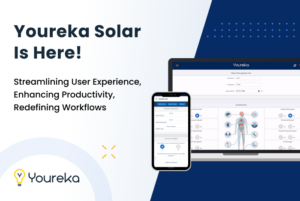
What is Business Automation?
Business Automation involves the strategic integration of technology to streamline and optimize repetitive, manual tasks across various departments and functions. This can range from simple administrative processes like data entry and document management to complex workflows involving multiple stakeholders and systems.
Business automation isn’t just about replacing human labor with machines. It’s about redesigning processes to leverage technology in a way that enhances efficiency, accuracy, and agility. By automating routine tasks, businesses can free up human capital to focus on higher-value activities such as innovation, customer engagement, and strategic decision-making.
By this point, leaders across a variety of industries understand the importance of using automation to increase efficiency. So much so that 50% of tech buyers said they would prioritize purchases that increase automation or save time (Insider Intelligence).
The Power of Automation
Imagine a world where you can free up qualified personnel from mundane tasks to work on more strategic priorities. Imagine replacing every phone call or email your business sends with automation.
This is automation. Automation allows you to do more with less.
By automating manual processes, organizations can eliminate bottlenecks, reduce cycle times, and increase output without proportionally increasing resources. This leads to greater operational efficiency and allows businesses to achieve more with existing resources.
Whether it’s handling a growing volume of transactions, managing complex supply chains, or servicing an expanding customer base, automation provides the scalability needed to support business growth without sacrificing quality or increasing overhead costs.
Automation is usually triggered by an action. For example, a client signs up for your email list and they receive a welcome email without anyone having to press send. This is a common example of how automation can save you time but automation can be used in a wide variety of business functions, particularly, in form management.
Organizations across industries use forms to capture crucial data that keep their businesses running. For example, in the oil and gas industry, they rely on forms to make sure they’re following safety protocols and complying with government regulations. In the manufacturing industry, companies use forms to build checklists for equipment maintenance and so much more.
But imagine instead of pen and paper, you are using mobile smart forms with conditional logic, data validation, and artificial intelligence to fill forms faster, more accurately, and with fewer personnel.
One of the primary benefits of automation is cost reduction. By automating repetitive tasks and optimizing resource allocation, organizations can achieve significant savings in terms of labor costs, operational expenses, and compliance-related penalties. For example, our smart forms can help ensure health, safety, and regulatory compliance in the oil and gas industry, saving our customers millions of dollars annually.
Every time someone at your organization uses a form, there’s an opportunity to improve processes, save money, and improve efficiency through automation. However, one of the common challenges in implementing automation is usually synchronicity with current systems and technology stack.
How can smart forms help you automate?
When it comes to automation, all forms are not created equal. Smart forms modernize the data collection process by streamlining data entry, validation, and processing. Features such as automated approvals and conditional data validation allow for
- Improved accuracy and reliability of data entry.
- Reduction in manual errors and associated costs.
- Time-saving through streamlined workflows and automated processes.
- Enhanced data security and compliance adherence.
Traditional paper-based forms are prone to errors, delays, and inefficiencies, whereas modern smart forms leverage technology to streamline data collection, validation, and processing.
Youreka smart forms, for example, enhance user experience by providing intuitive interfaces, real-time feedback, and seamless native integration with Salesforce. This not only accelerates data capture but also improves data quality and accessibility, empowering businesses to make informed decisions based on accurate and up-to-date information.
Imagine you’re onsite trying to close a big deal. You’re talking directly with the prospect and you ensure them that you can build a customized solution to fulfill their needs. They are happy with your solution and ready to move forward but they must get an accurate quote to see if your product will fit in their rigid budget constraints.
Enter Youreka’s live formulas and calculations. Without automation, you may need to open your laptop to a spreadsheet and plug in the formulas or manually calculate what the customized solution will cost. Or even worse, send the data you’ve collected from this prospect back to a member of your team at the office to provide a quote. As the old saying goes, time kills all deals. By the time you manually calculate the costs of your product, they may have already chosen another solution.
With form automation powered by Youreka, you’re able to instantly calculate the price of your product with their customizations and close the deal in the field without having to go back to the office.
Considerations for Implementation:
When diving into the implementation of transformative technologies such as automation, it’s imperative to prioritize both design and accessibility. No matter how cutting-edge the software may be, if it’s cumbersome or difficult for your team to navigate, its potential benefits could be severely diminished.
Integration with existing software is crucial. You don’t want to have to overhaul your entire tech stack to implement one new software or system. Overhauling your entire tech stack for the sake of one new system can be resource-intensive and disrupt workflow continuity. Rapid and extensive changes can overwhelm employees, leading to subpar implementation and lackluster usage.
Effective training and change management are indispensable in facilitating smooth transitions and fostering acceptance, especially among more resistant team members. Investing in comprehensive onboarding processes ensures that employees are equipped with the skills and knowledge necessary to leverage these advancements to their fullest potential. By fostering a culture of adaptability and providing adequate support, organizations can maximize the benefits of technological evolution while mitigating potential pitfalls.
How P&G used smart forms to automate processes
Procter & Gamble (P&G) overcame operational challenges by implementing smart forms, and revolutionizing their data collection and analysis processes. By providing in-form guidance and configurable templates, P&G empowered technicians of all levels to conduct efficient site visits, reducing dependency on senior staff and ensuring standardized data collection globally.
Challenge:
- Field techs were challenged with antiquated tools to support their complex forms and surveys creating inefficient site visits and lots of post-processing
- Manual processes with a dependency on field rep skill and experience to identify opportunities to expand current market share
- Inefficient data collection as human error created inconsistent site visit outcomes
- Inconsistent forms deployed globally across the organization disrupted reporting and analysis
Solution:
- In-form guidance allowed for junior technicians to begin conducting site visits historically reserved for senior technicians
- Configurable templates that could adapt to the specific environment being serviced were deployed, simplifying the on-site process
- Templates incorporated DiscoveriesTM and insights which assist end users in capturing relevant and consistent data through guided processes
- Form architecture created a scalable and reusable format, centrally managed for consistency
Procter & Gamble’s utilization of Youreka smart forms exemplifies how automation can revolutionize processes and drive tangible results. By leveraging smart forms for data collection and analysis, P&G streamlined operations, enhanced compliance, and achieved significant cost savings. This success underscores the transformative potential of smart forms in driving operational efficiency and competitiveness.
Conclusion
Efficiency is the cornerstone of success in today’s dynamic business environment. Leveraging automation and smart forms enables organizations to optimize resources, reduce costs, and stay ahead of the curve. By embracing innovation and investing in automation technologies, businesses can unlock new opportunities for growth and competitiveness.
Whether you need forms for compliance and safety purposes or for auditing locations to maintain brand standards, forms can be a nimble and effective part of the tech stack and encourage innovation and efficiency in your organization.
To learn more about how smart forms and automation can transform your business, schedule a demo with our team today.




